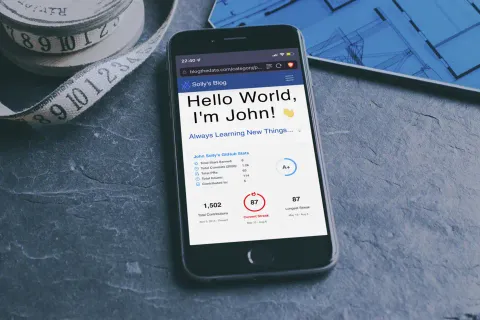Blogthedata.com: A blogging platform, on steroids

Purpose and Goal
They say publishing your work is one of the best ways to increase your luck. I love sharing things I’ve learned, so a technical blog perfectly combines the two. I want this site to be more than a portfolio. I want to help others get into geospatial web development by following my tutorials and cloning my repositories to learn.
Highlights
A blog might seem simple, but I’ve done considerable work under the hood. Whether getting an A+ on Mozilla’s observatory tool](https://blogthedata.com/post/how-to-get-a-perfect-mozilla-observatory-score/), achieving a perfect score on Google Lighthouse, having 100% unit test coverage, or even implementing a complete CI/CD pipeline with Github Actions.
Another unique feature is that I use HTMX to make the site feel like a single-page application. With HTMX, I could implement features like infinite scroll and partial page updates without a front-end framework like React or Vue. HTMX was a fun way to learn about modern web development without introducing a new language or framework.
Finally, you might notice if you peek at the code I am using, which does not have a CSS framework like Bootstrap or Tailwind. All components, like the navbar, accordions, and carousels, are custom-built. I did this to learn more about CSS and to have complete control over the look and feel of the site.
Tech Stack
When I started building this site, I had the most experience with Python, so I decided to use Django mainly because I could do both the front and backend without messing with JavaScript. I wanted to learn more about server configuration, so I set everything up on an Ubuntu box hosted by Linode and used an Apache web server. I had to handle all the security, firewall rules, and SSL, but it was a good learning experience. At one point, I decided I wanted to explore more modern tools, so I migrated from Apache to NGINX + Gunicorn.
I am proud to say that this site is a pure Django application with no front-end framework. I use Django’s templating language to render the HTML and HTMX to make the site feel like a single-page application. I also use Django’s built-in admin interface to manage the content and Django’s ORM to interact with the database. I use Postgres as my database and Django’s built-in testing framework to write unit tests. I use Cloudflare as my CDN and Github Actions for CI/CD.
Lessons Learned
I want to implement this issue and move the site to a PaaS solution like Heroku. Learning all the ins and outs of deploying an application was fun, but these providers abstract all that away so I can focus on things that bring real value to my application.
I also want to be more careful about relationships between objects/tables. I neglected to make a foreign/primary key relationship between posts and categories, forcing me to go through a complex database migration to add it later.
One of the trickiest changes was migrating from SQLite to Postgres. I made a Youtube video about all the issues I had to resolve.
Another significant change was migrating from ckeditor4 to ckeditor5. At the time, the ckeditor5 integration for Django was brand new, and I logged ten issues in the ckeditor5 repo (as of 7/31/22). I even fixed one of them myself and became an official contributor to django-ckeditor5. Collaborating with another developer to improve a package used by hundreds of people was rewarding.
I also implemented some features that I removed because they didn’t make sense. For example, I allowed users to log in and comment on posts, but I pulled this functionality because I decided it wasn’t worth my extra effort to moderate content. I also implemented a honeypot page but needed to remove it because it was incompatible with Django 4.0, and the package maintainer was no longer updating it. After adding the site to a CDN, I found that the way I was tracking post views was no longer accurate because users were no longer hitting my server but instead got cached copies of my site from the CDN edge servers.
Future Plans
While I always respond to open-source contributions, I see my blog as a relatively mature project. I don’t plan to add new features, but I will continue to add blog posts and patch any security issues that crop up.